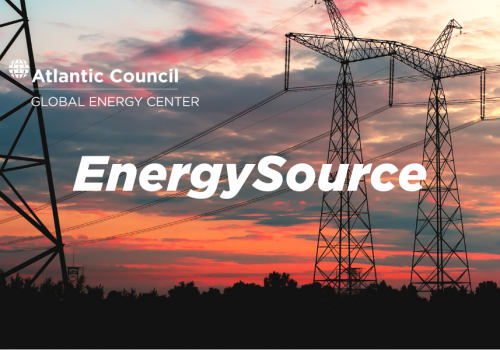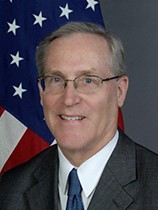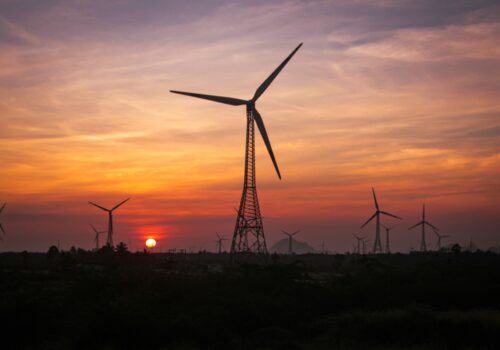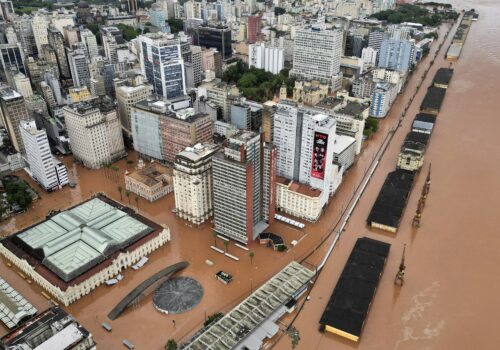Understanding the energy and water nexus is vital to combating climate change. Global demand for both continues to grow as populations, cities, and incomes expand. Climate change increases rainfall variability, causing more destructive droughts and floods, and affecting hydropower’s ability to supply low-emission electricity and stabilize the grid. Climate impacts will boost energy demand for irrigation and desalination, and stress electricity transmission and utility water systems.
At this month’s COP29 in Baku, greater attention must be given to the complex relationship between energy and water. The meeting should promote long-term policies, strategies, and investments to meet this challenge.
STAY CONNECTED
Sign up for PowerPlay, the Atlantic Council’s bimonthly newsletter keeping you up to date on all facets of the energy transition.
Hydropower’s role in the global energy system
Hydropower is the world’s single-largest source of renewable power. But most clean energy development analyses, including the 2024 World Energy Outlook by the International Energy Agency (IEA), emphasize the role of solar and wind in the energy transition. Their growth over the past decade has indeed been unprecedented; the IEA forecasts that global hydropower generation will be overtaken by solar photovoltaics in 2029 and by wind in 2030. Nevertheless, hydropower still contributes 14 percent of global power generation and 35 percent of the world’s non-fossil electricity. Hydropower is widespread in all regions, with 89 countries boasting installed capacity over 1,000 megawatts. Nine countries across four continents depend on hydropower for over 75 percent of their electricity generation, while another fourteen rely on it for more than half.
But drought and flood conditions have left this important power source vulnerable—after remaining constant for over a decade, hydropower output fell in 2021 and 2023 despite new capacity additions and improvements to older units.
New stresses, new demands
Climate change has exacerbated water stress. The World Resources Institute finds that a quarter of the world’s population lives in countries facing extreme drought conditions, notably in the Middle East, North Africa, and South Asia. Many other nations experience high water stress for at least one month a year.
This has a serious impact on power production. Droughts reduced hydropower generation by 8 percent in India during the first half of 2024. Droughts not only require increased thermal power use; they also reduce the availability of water for cooling thermal plants. In 2020, about 22 percent of global energy-related water use was for cooling thermal plants, drawn largely from freshwater sources. These volumes are projected to increase to at least 35 percent of world water use by 2050.
The agricultural sector is being profoundly affected by increased drought and record high temperatures. Irrigation systems, especially the expansive diesel and electric groundwater tubewell systems of South Asia, require increased energy supplies. A 2024 study suggests that future irrigation system expansion could increase energy consumption in irrigation worldwide by 28 percent.
Demand for desalination has risen about 7 percent per year in order to meet growing freshwater needs and groundwater depletion. Desalination plants are energy intensive, with total plant electricity consumption ranging from 1.3 kilowatt-hour (kWh) per cubic meter of water in new plants to as much as 3 kWh in older ones. This energy load and associated costs may strain electricity and water systems, as well as increase emissions if powered by fossil fuels. Desalination is expanding in a number of regions, notably in the Middle East and North Africa, which has the largest regional desalination capacity. Since 2022, the Algerian Energy Company has begun building five new desalination plants to augment the nineteen currently in operation. To reduce dependence on natural gas, the government is looking to use renewable energy to power these units.
Climate-induced severe weather comes at high cost
The severity of storms and floods have intensified in recent years, inflicting damage on energy and water infrastructure. Communities are being left devastated by severe weather events, such as the back-to-back hurricanes Helene and Milton in the United States.
The destruction of watersheds, including by wildfires that have reduced their ability to retain water, has resulted in mudslides and polluted lakes, rivers, and reservoirs with debris. Dams are critical to controlling water flows, but large floods put them under stress, with older facilities particularly impacted. In the United States alone, it is estimated that rehabilitating approximately 15,200 high-hazard dams will cost $24 billion.
The time for action is now
The energy-water nexus is creating new uncertainties for energy and climate planning, requiring a more integrated analytical framework for decisions on strategic investment. COP29 should support the development of improved data and monitoring of key energy-water indicators—such as reservoir and river flow levels, energy use and efficiency in water utilities, water prices, and infrastructure investment—that can be incorporated into national climate and energy plans.
Although it would be wise for hydro-dependent countries to diversify their clean generation, there still exists significant potential for new hydropower capacity, even though the IEA sees only marginal future growth contributing to emissions reduction. The International Hydropower Association estimates global hydropower potential stands at 1,782 gigawatts (GW), even larger than total installed capacity in 2023 of 1,416 GW, which includes pumped storage. Africa has the largest regional potential at 487 GW, but the lowest installed capacity of only 42 GW.
The International Renewable Energy Agency estimates that to meet net-zero emission goals, hydropower needs to double by 2050, requiring a much higher level of investment than the current $50-60 billion annually. Although China has been the largest international financier of hydropower projects, multilateral financial institutions have increased their funding over the past decade. The African Development Bank’s $1 billion program to upgrade twelve hydropower plants in Africa is an example of such funding.
Private sector participation is also critical to achieving net-zero goals through hydropower. Promising areas for private investment include pumped storage projects that can contribute to grid stability and store water, as well as desalination plants, which require large amounts of clean energy.
As COP29 pursues its mission to enhance ambition and enable climate action, clearer and stronger commitments—such as those that emerged on methane from public and private actors at COP28—are needed to meet the energy and water challenge. Addressing this critical issue is central to enabling emissions reduction and adaptation, and remedying loss and damage.
Robert F. Ichord, Jr. is a nonresident senior fellow at the Atlantic Council Global Energy Center.
MEET THE AUTHORS
RELATED CONTENT
OUR WORK

The Global Energy Center develops and promotes pragmatic and nonpartisan policy solutions designed to advance global energy security, enhance economic opportunity, and accelerate pathways to net-zero emissions.
Image: Hydropower dam. (American Public Power Association, Unsplash) https://unsplash.com/photos/water-dam-under-white-and-blue-skies-FUeb2npsblQ





